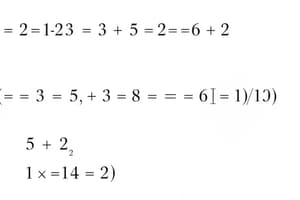Podcast
Questions and Answers
What is a function?
What is a function?
A special type of relationship in algebra where two quantities are related to each other so that one quantity depends on the other.
What is function notation?
What is function notation?
A type of writing that uses a letter to name a function and places parentheses around the independent variable.
What is the domain in a function?
What is the domain in a function?
The set of all allowable input values.
What is an input?
What is an input?
What is an input-output diagram?
What is an input-output diagram?
What is output in a function?
What is output in a function?
What is the range of a function?
What is the range of a function?
What does mapping refer to in functions?
What does mapping refer to in functions?
What is a mapping diagram?
What is a mapping diagram?
What is a relation?
What is a relation?
What is an input-output table?
What is an input-output table?
What is a table in the context of functions?
What is a table in the context of functions?
What is an ordered pair?
What is an ordered pair?
What does vertical mean in a coordinate plane?
What does vertical mean in a coordinate plane?
What is the vertical line test?
What is the vertical line test?
What does horizontal mean in a coordinate plane?
What does horizontal mean in a coordinate plane?
What is the horizontal line test?
What is the horizontal line test?
What is a many-to-one function?
What is a many-to-one function?
What is a one-to-one function?
What is a one-to-one function?
What is an arithmetic sequence?
What is an arithmetic sequence?
What is a common difference?
What is a common difference?
What is a common ratio?
What is a common ratio?
What is exponential decay?
What is exponential decay?
What is exponential growth?
What is exponential growth?
What is a geometric sequence?
What is a geometric sequence?
What is a sequence?
What is a sequence?
What is the commutative property?
What is the commutative property?
Flashcards are hidden until you start studying
Study Notes
Functions and Relations
- A function indicates a relationship where one quantity depends on another, establishing a dependent and independent variable connection.
- Function notation employs a letter designation for the function, using parentheses for the independent variable (e.g., F(x) pronounced "F of x").
- The domain consists of all permissible input values, represented by x-values in a function's graph.
- Input refers to the value entered into a function, represented as the independent variable.
Diagrams and Tables
- An input-output diagram visualizes the connection between inputs and outputs in a function.
- Output signifies the result produced by a function, considered the dependent variable.
- The range encompasses all output values that a function can produce (y-values).
- Mapping represents the structured connection of inputs to outputs; if each input links to only one output, it is classified as a function.
- A mapping diagram illustrates how specific relations pair input values with output values.
- An input-output table lists input values in the first column and corresponding output values in the second, representing domain and range.
- A table is a structured format for displaying data, organized in rows and columns for clarity.
Coordinate Geometry
- An ordered pair, defined in parentheses, indicates a point's location on a coordinate plane, comprising an x and y value.
- Vertical lines run straight up and down on a coordinate plane; their equation takes the form x = a, where 'a' is a constant.
- The vertical line test evaluates if a graph represents a function—if it intersects multiple points with a vertical line, it’s not a function.
- Horizontal lines extend from left to right in a coordinate plane, written as y = a, with 'a' as a constant.
- The horizontal line test checks if a graph is a one-to-one function.
Types of Functions
- A many-to-one function maps multiple x-values to a single y-value.
- A one-to-one function links each y-value to one unique x-value.
Sequences
- An arithmetic sequence maintains a constant difference between consecutive terms.
- The common difference refers to the fixed value separating consecutive numbers in an arithmetic sequence.
- A geometric sequence involves maintaining a consistent ratio between successive terms.
- The common ratio is the consistent multiplier between consecutive numbers in a geometric sequence.
- Exponential growth describes a quantity increasing by a common ratio at regular intervals, while exponential decay refers to a quantity decreasing in the same manner.
- A sequence presents an ordered pattern of numbers, exemplified by decreasing terms such as 11, 7, 3, -1, etc.
Properties of Operations
- The commutative property states that the order of addition or multiplication does not affect the result (e.g., a + b = b + a).
Studying That Suits You
Use AI to generate personalized quizzes and flashcards to suit your learning preferences.




